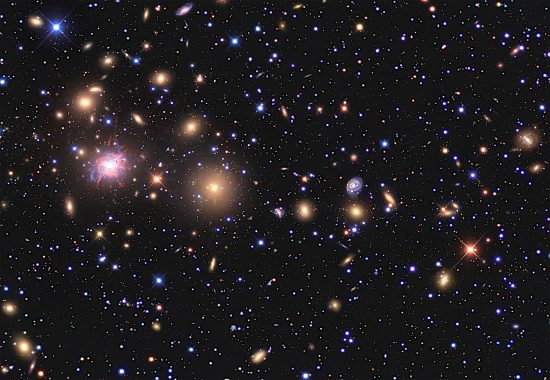
The Perseus Galaxy Cluster. Credit: R. Jay Gabany
Jul 13, 2016
The conventional Universe is a mirage.
In the days before space shuttles, before the Hubble Space Telescope, and before modern satellite technology, electricity in space was not considered. Because the first teams of space scientists were “steely-eyed missile men” with backgrounds in aeronautics and chemical fuel reactions, when evidence for electricity around Earth was discovered it was called “radiation belts”.
Electricity remained unfamiliar to those conditioned by consensus science. Although Kristian Birkeland conducted experiments fifty years before the first payload was launched into Earth orbit, astrophysicists had no concept of charged particles that can interact and create energetic phenomena—Birkeland’s terella research and his study of Earth’s aurorae were forgotten.
The same attitude remains today. Moving charged particles from the Sun are called a “wind” instead of an electric current. Charged particles impinging on a planet or a moon are referred to as “rain” instead of an electrical discharge. Ionized particles moving within a helical magnetic field are called “jets of hot gas” instead of field-aligned flows of electricity. When abrupt changes in the density and speed of charged particles are observed, those changes are called “shock waves”. Birkeland frets from beyond the pale.
Electric charge in motion (coulombs per second = amperes) creates magnetic fields that are detected more easily than electric charge. Modern astronomical theories suggest that the fields are primordial “embedded fragments” left over from the Big Bang.
Galaxy clusters are thought to be made of individual galaxies embedded in hot gases and dark matter. Inside the clusters are bright radio sources that might be the result of exploding double layers that are composed of highly energetic particles in the plasma state. Conventionally, though, the cause of the explosions and the source of the particles is not known.
The fact that moving charges constitute an electric current and that those currents generate magnetic fields has been known since the days of Michael Faraday. However, as the saying goes: “perception is reality”, so a lack of knowledge means a lack of vision. As previously stated, charged particles in motion constitute an electric current and that current is wrapped in a magnetic field. As more charged particles accelerate in the same direction, the magnetic field gets stronger. That idea is familiar to electrical engineers, but when astronomers find magnetism in space they are mystified. They resort to ironic ideas about galaxy-wide voids with magnetic fields frozen inside them.
On the largest scale of all, energetic events are not explained by reference to local conditions. The effects of an entire electric circuit—which may encompass clusters of galaxies—must be considered. For electric charge to flow, it must flow in a circuit. The consensus scientific worldview only permits isolated galactic “islands” in space. The Electric Universe theory, on the other hand, emphasizes connectivity with a vast network. That spatial network is composed of Birkeland currents.
Loops and filaments suddenly expand and explode, throwing off massive bubbles of plasma that can accelerate to near light-speed. Jets from opposite poles of a galaxy end in energetic clouds emitting copious radio and X-ray frequencies. These are facts based in plasma science and not the traditional theories of gas kinetics, gravity, or particle physics. Astrophysicists see magnetic fields, but they do not perceive the underlying electricity, so they are at a loss to explain them.
Matter in the plasma state behaves in unfamiliar ways. It is habitual perception that makes it difficult to see plasma as something different. By breaking free from a priori assumptions, the unfamiliar behavior of plasma will become familiar and astronomers will perceive a new Universe.
Stephen Smith












